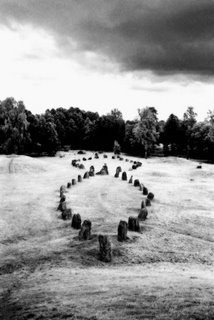Tomorrow I will be guest teaching in HUMlab for a seminar on Electronic Literature. The reason I am a guest is because I am officially on parent leave, but with the Literature Department holding a 3 hour seminar on Electronic Lit., centred upon
Michael Joyce's Afternoon; A Story, I really wanted to come in and participate.
What I am planning on doing is discussing two points that are apparent in
Afternoon and that are still relevant all these years later to hypertext and other forms of digital literature; The Reader and The Link. So here is my lesson plan/notes for my hour or so on the spot tomorrow (I am sharing it with
Patrik and will be using this entry in the talk):
Reading and the Poetics of the Link"A link in hypertext is, from the reader's perspective, a whole new literary joy, and, from the writer's perspective, an aspect of form and craft to be used along with other stylistic and formal tools."
The Poetics of the Link by Jeff Parker (
http://www.altx.com/ebr/ebr12/park/park.htm)
As Parker points out in his essay
The Poetics of the Link, the hypertext link is not just "merely a connector, a glorified page to turn". So what is it??
I look to George Landow's recent
Hypertext 3.0 for some classifications of hypertext links:
1. Lexia to Lexia Unidirectional
Direct link from one screen image to another without a return link. The return button on most web browsers makes this a difficult classification.
Lexia refers to a single node of text in a digital artefact, the boundaries of which may be at times difficult to determine but generally rest upon a single observable visual field. The term has been widely adopted in the digital theory context from Roland Barthes' Image Music Text (1977): "lexical unit or lexia (of the same image)" Roland Barthes. "Rhetoric of the Image"
Image Music Text Trans. Stephen Heath (New York, Hill and Wang, 1977) 46.
2. Lexia to Lexia Bidirectional
Because of the return function on web browsers this is usually the case with World Wide Web (W3) links.
Afternoon has: One L) mouse click foward two clicks back, the History button that opens a list of lexia visited and permits the return to each, the Return button (as is the case with web browsers) and the Bookmarks funtion that allows a point to be marked for latter reference.
3. String (word or phrase) to Lexia
This is the situation with Afternoon. Each linked word or phrase opens a new lexia to the one that contains the link. According to Landow (2006):
"Advantages: (1) Allows simple means of orientating readers; (2) permits longer lexias (3) encourages different kinds of annotation and linking." George Landow
Hypertext 3.0: Critical Theory and New Media in an Era of Globalization(Baltimore: John Hopkins UP, 2006)12-14.
Landow discusses other types of linking strategies but these three are a good enough start. So the link moves the reader through the text. In doing this it creates:
1. An illusion of movement (and as a consequence a sense of space and place) as the text unfolds with an authored/designed intention. This "movement" is guided by the postioning and content of links.
2. It provides a rhythm for navigating the text. Uniform links in easy to find spots allows for a uniform reading pace. Hidden and trick links makes things more "playful".
3. A link can create a phrase which begins with the clickable point (the first sign in the phrase) and then continues over into the opened link. One example is "Do you want to hear about it?" of the opening lexia of
Afternoon. Each of the words of the "Do you want to" of the phrase "Do you want to hear about it?" are linked to the following lexia; "I want to say I may have seen my son die this morning." The word "hear" is linked to a lexia of the story of Lolly and Nausicaa. The final "about it?" returns us to "I want to say I may have seen my son die this morning." This is a narrative arrangement constucted in the authoring of the text. Katherine Hayles writes that
"In Michael Joyce's hypertext novel Afternoon, all the textual nodes have equal claim to being "primary". In a narrative such as this, there is no predetermined plot. Rather, there are potential pathways that are actualized when a user traverses them. The actual narrative comes into existence (emerges globally) in conjunction with a specific reading." N. Katherine Hayles, "Artificial Life and Literary Culture" in Cyberspace Textuality: Computer Technology and Literary Theory, Marie-Laure Ryan (Ed) (Bloomingdale: Indiana UP. 1999) 213.
In applying Hayles' horizontal model of the text the link becomes the structuring principle of the narrative. It allows the narrative to be built by providing the illusion of movement through the text. There is only a beginning when the reader engages with the text and the end when the reader leaves the physical text. In between are the paths of the links, the narrative spaces opened with each click.
Now I would like to discuss something else unique to such electronic literature as
Afternoon, the End User Licence Agreement (EULA). This is the EULA for Afternoon, by today's standards it is very simple but the manner of address and rules are basically the same:
LICENSE AGREEMENT:
=================
Eastgate Systems, Inc., grants you a non-exclusive license to use this copy of the program on the following terms:
YOU MAY:
I) Use the program on any ONE computer.
YOU MAY NOT:
I) Allow the program or any other document created by the installer into the possession or use of any other individual or organization, without prior express written consent of Eastgate Systems, Inc.;
II) Modify, translate, reverse engineer, decompile, disassemble, create derivative works based upon, or copy the program or the accompanying documentation;
III) remove any proprietary notices, labels, or marks on the program and accompanying documentation;
IV) use this program, or permit this program to be used, on more than one computer at any one time.
Non-compliance with any of the above restrictions will terminate this license.
This license is not a sale. Title and copyrights to the program and accompanying documentation and any copy remain with Eastgate Systems, Inc.
This agreement is the entire agreement. If any provision of this agreement is held invalid, the remainder of this agreement shall continue in full force and effect.
afternoon, a story_ copyright © 1987 by Michael Joyce. All Rights Reserved. Software copyright © 1992-2001 by Eastgate Systems, Inc. All Rights Reserved.
Installation:
============
To install _afternoon, a story_ for Windows, follow the instructions given by this installer.
Installation creates a new program group named "afternoon", containing three items:
- _afternoon, a story_
- "Reading _afternoon, a story_" -- a brief manual on reading the hypertext. To best enjoy _afternoon_, please have a look at this manual.
- A free coupon for your next purchase of an Eastgate publication.
If you do not specify otherwise during instalLation, the "afternoon" program group is added to the HYPERTEXTS program group.
Installation places all the files it creates in a new directory named "AFTRNOON".
The manual and the coupon are in PDF format, for Adobe Acrobat Reader.
Microsoft®, Windows®, Windows 95®, Windows 98®, Windows 2000®, Windows me®, and Windows NT® are registered trademarks of Microsoft Corporation. Apple is a registered service mark and Macintosh(tm) and Mac OS(tm) are trademarks of Apple Computer, Inc. Adobe(tm) and Acrobat(tm) are trademarks of Adobe Systems Incorporated.
Other product names mentioned in this document may be trademarks or registered trademarks of their respective owners. Product names are used for identification only, with no intent to infringe. Mention of third-party products is for informational purposes only and constitutes neither an endorsement nor a recommendation Eastgate Systems, Inc., assumes no responsibility with respect to the performance or use of these products.
In the early years of hypertext theory the catch cry was:
"Hypertext demands an active reader; it blurs the distinction between author and reader."
(Landow, Hypertext, 178-79, 184; Lanham, The Electronic Word, 6, 76; Bolter, Writing Space, 29, 117, 153-59.)
I am not so sure about this statement. What I think instead is that hypertext, and what has developed from it, has blurred what is a reader and an author, both in old and new media. The EULA is a document lending weight to the idea that authorial power is still asserted in the text, that the reader is guided in how she is expected to read, and what he is allowed to do with the text. Of course, acting against these expectations are the many deviant forces of digital media; the remixer, the hacker, the copyist, the parody and plagiarist. It is this sense that the distinction between author and reader may be considered blurred, but not to the point, thus far, where one threatens the other. The Law sees to that.



























